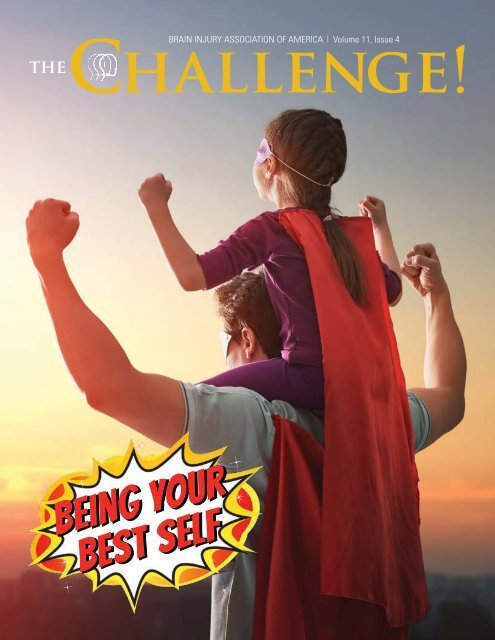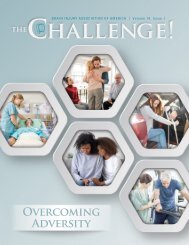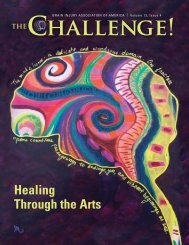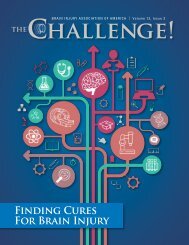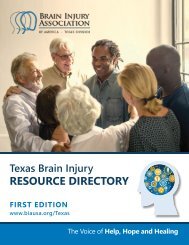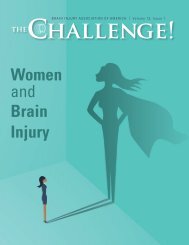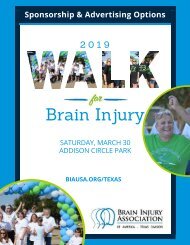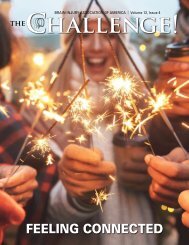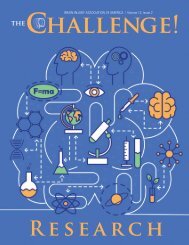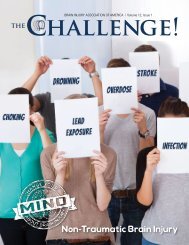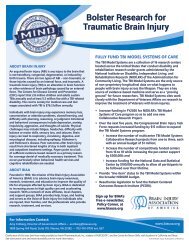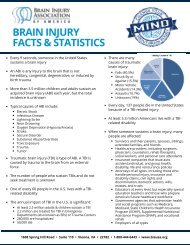Being Your Best Self
Fall 2017
Fall 2017
Create successful ePaper yourself
Turn your PDF publications into a flip-book with our unique Google optimized e-Paper software.
BRAIN INJURY ASSOCIATION OF AMERICA | Volume 11, Issue 4<br />
Challenge!<br />
the<br />
<strong>Being</strong> <strong>Your</strong><br />
<strong>Best</strong> <strong>Self</strong>
Table of CONTENTS<br />
FALL 2017<br />
THE Challenge! is published<br />
by the Brain Injury Association<br />
of America. We welcome<br />
manuscripts on issues that are<br />
important to the brain injury<br />
community. Please send<br />
submissions in a standard<br />
Microsoft Word ® document to<br />
publications@biausa.org.<br />
4› Returning to Work<br />
After Brain Injury<br />
8› Hart and Weintraub<br />
Named as BIAA Award<br />
Recipients Award Winners<br />
Recognized for Contributions<br />
to Research and Clinical Care<br />
4<br />
For more information regarding<br />
advertising in THE Challenge!,<br />
please visit www.biausa.org.<br />
Association Staff & Volunteers:<br />
Marianna Abashian<br />
Greg Ayotte<br />
11› Goal Setting<br />
14› “The Concussion Girl”<br />
16› Honor Roll of Donors<br />
11<br />
Christine Chen<br />
Stephanie Cohen<br />
Amy C. Colberg<br />
Susan H. Connors<br />
William Dane<br />
Sarah Drummond<br />
Tiffany Epley<br />
Dianna Fahel<br />
Holly Kisly<br />
Jessica Lucas<br />
18› <strong>Being</strong> a Bumble Bee<br />
20› Advocacy Update<br />
23› State Affiliate News<br />
27› Brain Injury Advisory<br />
Council Corner<br />
Member Spotlight:<br />
Stephanie Freeman<br />
Specific<br />
Measurable<br />
Achievable<br />
Relevant<br />
14<br />
Time-bound<br />
Jennifer Mandlebaum<br />
Carrie Mosher<br />
29› The BIAA Bookshelf<br />
Jordan Ortiz<br />
Mary S. Reitter<br />
Postmaster:<br />
Send address changes to:<br />
THE Challenge!<br />
1608 Spring Hill Rd., Suite 110<br />
Vienna, VA 22182<br />
Copyright 2017 BIAA<br />
All rights reserved.<br />
No part of this publication may<br />
be reproduced in whole or in<br />
part without written permission<br />
from the Brain Injury Association<br />
of America. Email requests to<br />
publications@biausa.org.<br />
30› News and Notes<br />
30› Upcoming Webinars<br />
26<br />
20<br />
Publication designed by<br />
Eye to Eye Design Studio, LLC<br />
www.eyetoeyedesignstudio.net<br />
Please recycle this issue.<br />
2
From my DESK<br />
Thank you to the many readers who expressed appreciation for<br />
the summer issue of THE Challenge!, focused on research. The<br />
Brain Injury Association of America (BIAA) is always pleased<br />
to highlight the work of government agencies, hospitals,<br />
universities, and other institutions in our shared goal to<br />
advance brain injury research. Recently, we teamed up with<br />
SanBio to help recruit participants for a clinical trial called<br />
STEMTRA (Study of Modified Stem Cells in Traumatic Brain<br />
Injury). To learn more, visit https://tbiresearchstudy.org.<br />
I send a great big<br />
shout out to the many<br />
generous contributors<br />
who donated their<br />
precious time and<br />
money to BIAA<br />
throughout 2017 –<br />
we would be lost<br />
without you.<br />
Thank you to the volunteer leaders and paid staff professionals<br />
from BIAA affiliates across the country who gathered for the<br />
22nd Annual Leadership Conference, Nov. 8-10, in sunny<br />
Florida. In addition to the training and networking that occurs<br />
throughout the meeting, BIAA also takes this opportunity to<br />
recognize affiliates that deliver exceptional programs and<br />
services. This year’s Award of Excellence winners are: the<br />
Brain Injury Associations of Georgia, Kansas and Greater<br />
Kansas City, Louisiana, Maryland, Massachusetts, Michigan,<br />
New Hampshire, and New York State. BIA of Missouri’s<br />
chief volunteer leader, David Dyck, Jr., DO, and chief staff<br />
professional, Maureen Cunningham, CFRE, were also honored.<br />
November is National Family Caregivers Month. THE Challenge!<br />
readers will want to take a moment to acknowledge how<br />
important caregivers are in helping individuals who have been<br />
injured regain the maximum level of independence possible. If<br />
there is a special caregiver in your life, please say thank you!<br />
#GivingTuesday also takes place in November, and SanBio<br />
has agreed to be our sponsor for the online event. They'll<br />
be matching gifts up to $2,100, so please consider making<br />
a donation on that day. For more information about<br />
#GivingTuesday, follow us on Facebook, Twitter, and Instagram.<br />
And finally, I send a great big shout out to the many generous<br />
contributors who donated their precious time and money to<br />
BIAA throughout 2017 – we would be lost without you.<br />
The brain injury community has BIAA’s best wishes for a happy<br />
and safe holiday season.<br />
Susan H. Connors, President/CEO<br />
Brain Injury Association of America<br />
www.biausa.org 3
RETURNING<br />
TO WORK<br />
AFTER BRAIN<br />
INJURY<br />
By Margaret Koch, Director of Vocational Services, Hope Network Neuro Rehabilitation<br />
Work is such an important part of our lives —<br />
it gives us meaning and purpose. Having<br />
a job that we do well allows us to feel<br />
competent and successful. Work is a good place to<br />
meet people and make friends. Earning a paycheck<br />
also helps us meet our needs and support our families.<br />
But a brain injury can throw a big wrench into the<br />
picture. You may experience challenges with memory<br />
and attention, making it hard to manage the various<br />
stimuli in the environment. You might have physical<br />
challenges and your social skills may be affected.<br />
Things that used to be easy may now be more difficult.<br />
You might wonder what’s to come or have other<br />
questions and concerns. For example, you may ask:<br />
Will I be able to do the things I did before my injury?<br />
Will I be able to go back to work? Will I need to find<br />
a different job? Who will help me with my return to<br />
work journey?<br />
No wonder it can be difficult to figure out how to<br />
get back to work! Fortunately, there are resources to<br />
point you in the right direction and help you meet<br />
your goals of returning to work after a brain injury,<br />
whether that means building skills, returning to a<br />
previous job, or finding a new job.<br />
4
ELEMENTS OF A RETURN TO WORK PLAN:<br />
Vocational Rehabilitation:<br />
Where to Begin?<br />
Vocational rehabilitation (VR) programs can be<br />
helpful to you and your family as you begin the<br />
process of returning to the workforce. These<br />
programs can help you determine where you are,<br />
where you want to go, and how to get there. This<br />
might include services such as:<br />
• Vocational evaluations<br />
• Situational assessments<br />
• Work adjustment services<br />
• Interest testing<br />
• Vocational counseling<br />
• Job analysis<br />
• Identifying job accommodations<br />
VR programs help you get back to work. If you were<br />
working before your injury, it is best to start thinking<br />
about VR sooner rather than later. As you consider<br />
your options, it is also helpful to talk to your social<br />
worker, case manager, and doctor about returning to<br />
work. Here are some other tips to get you started:<br />
KNOW YOUR RIGHTS<br />
The Americans with Disabilities Act (ADA) was<br />
signed into law to make American society accessible<br />
to everyone, including people with brain injuries.<br />
Title I of the ADA deals with employment and<br />
requires companies with 15 or more employees to<br />
provide reasonable accommodations to applicants<br />
and employees with disabilities. The law also<br />
prohibits discrimination on the basis of disability<br />
in all aspects of employment. For more information<br />
about the ADA and reasonable accommodations,<br />
visit the Job Accommodation Network website:<br />
http://Ask.JAN.org/links/adalinks.htm#1 or visit<br />
https://www.dol.gov/general/topic/disability/ada.<br />
(continued on page 6)<br />
www.biausa.org 5
(continued from page 5)<br />
CONTACT HUMAN RESOURCES<br />
The human resources department at your<br />
employer will be able to help you determine if you<br />
qualify for any benefits, such as short- or longterm<br />
disability insurance. If you have worked for<br />
your employer for at least one year, you may also<br />
qualify for the Family Medical Leave Act (FMLA),<br />
which protects your job for up to 12 weeks while<br />
you are recovering. FMLA may also be available<br />
to your family members if they need to take a<br />
leave of absence to care for you. When you are<br />
ready to return to work, you should talk to your<br />
employer about allowing you to come back with<br />
accommodations to help you with your transition.<br />
How to Pay for<br />
Vocational Rehabilitation<br />
Unfortunately, private health insurance benefits<br />
do not cover vocational rehabilitation; however,<br />
there are other options available.<br />
1<br />
2<br />
3<br />
If you were injured at work, you are<br />
entitled to Workers’ Compensation<br />
insurance, which provides wage<br />
replacement and medical benefits<br />
(benefits vary from state to state).<br />
If you were injured in a motor-vehicle<br />
accident, you may be entitled to medical<br />
and rehabilitation benefits through your<br />
automobile insurance. Some states have<br />
Auto No-Fault Insurance for treatment<br />
that is reasonable and necessary,<br />
including brain injury rehabilitation.<br />
For more information, contact your<br />
insurance company.<br />
If neither of those options are available<br />
to you, contact the VR agency in your<br />
state. These programs provide vocational<br />
and rehabilitative services to individuals<br />
with disabilities to help them prepare for,<br />
obtain, regain, or maintain employment.<br />
To find the VR agency in your state, visit:<br />
http://www.askearn.org/state-vocationalrehabilitation-agencies/.<br />
6
What if I’m not ready to<br />
go back to work right now?<br />
Even if you aren’t ready to go back to work yet, you can<br />
take other steps to become prepared. First, contact your<br />
human resources department to find out your benefit<br />
status. Next, make sure that your family, employer,<br />
doctor, and rehabilitation team know that you want to<br />
go back to work. Participate in vocational assessment<br />
and counseling and in vocational rehabilitation to<br />
identify your current strengths and challenges.<br />
Going back to work, whether it’s the job you did<br />
before or a different one that matches your new<br />
strengths, is a major goal for many people with brain<br />
injury. Thinking about returning to employment early<br />
on can help you and your family develop a plan that<br />
will help you to be successful.<br />
Margaret Koch, B.A., is a Certified Brain Injury Specialist (CBIS) with more<br />
than 35 years of vocational rehabilitation experience. She has been the<br />
leader of the Grand Rapids Chapter of the BIA of Michigan for more than<br />
20 years. Margaret can be reached at 616-940-0040, ext. 18270 or by email<br />
at mkoch@hopenetwork.org.<br />
Look out for BIAA’s<br />
New Website in 2018!<br />
www.biausa.org 7
HART AND WEINTRAUB<br />
Named as BIAA Award Recipients<br />
AWARD WINNERS RECOGNIZED FOR<br />
CONTRIBUTIONS TO RESEARCH AND CLINICAL CARE<br />
Each year, the Brain Injury Association of America (BIAA) presents the William Fields Caveness Award in<br />
recognition of an individual who, through research on both a national and international level, has made<br />
outstanding contributions to bettering the lives of individuals with brain injury.<br />
Tessa Hart, Ph.D., is the recipient of the 2017 William Fields Caveness Award.<br />
Tessa Hart, Ph.D., is institute scientist at the Moss Rehabilitation<br />
Research Institute in Elkins Park, Pennsylvania, where<br />
she directs the Traumatic Brain Injury (TBI) Clinical<br />
Research Laboratory and the Moss TBI Model<br />
System. She is also research professor in the<br />
department of rehabilitation medicine at Sidney<br />
Kimmel Medical College, Thomas Jefferson<br />
University, Philadelphia. Dr. Hart’s wide-ranging<br />
research interests include creating and testing<br />
treatments to improve executive function,<br />
emotional function, and self-regulation. Her other<br />
interests include vocational rehabilitation for<br />
TBI and the use of assistive technology for<br />
cognition. Dr. Hart further advances the field<br />
of brain injury rehabilitation by serving<br />
on multiple peer review panels, editorial<br />
boards, and national and international<br />
task forces.<br />
8
The Sheldon Berrol M.D. Clinical Service Award is presented annually to an individual who, through a long<br />
service career, has made outstanding contributions to improving the quality of care, professional training,<br />
and/or education in the field of brain injury.<br />
Alan Weintraub, M.D., is the Sheldon Berrol M.D. Clinical Service Award winner.<br />
Alan Weintraub, M.D., has been medical director of the<br />
brain injury program at Craig Hospital since 1986.<br />
Dr. Weintraub has also served as medical director<br />
of post-acute residential brain injury programs<br />
and several long-term subacute brain injury<br />
programs. He is an associate clinical professor<br />
at the University of Colorado Health Sciences<br />
Center and an active consultant to the Colorado<br />
Division of Workers’ Compensation Medical<br />
Treatment Guidelines TBI Task Force. As a Brain<br />
Injury Medicine Certified Subspecialist, Dr. Weintraub<br />
has special interests in predictive biomarkers for<br />
recovery, neuroimaging, pharmacological rehabilitation<br />
management, sports-related concussion, and the<br />
long-term consequences of brain injury. He<br />
is actively involved in local, regional, and<br />
national organizations and is devoted<br />
to addressing the aging and long-term<br />
needs of persons with brain injury and<br />
their families. For more than 30 years, Dr.<br />
Weintraub has lectured extensively to<br />
broad audiences and written on a number<br />
of specific topics related to both traumatic<br />
and acquired brain injury.<br />
The awards were presented at the conference of the American Congress of Rehabilitative Medication (ACRM),<br />
held Oct. 23-28 in Atlanta, Georgia.<br />
www.biausa.org 9
GOAL SETTING<br />
Specific<br />
Measurable<br />
Achievable<br />
Relevant<br />
Time-bound<br />
By Celeste Campbell, Psy.D.<br />
Come with me on a trip! Ready? Let’s go!<br />
I<br />
imagine most of you are thinking, “A trip to<br />
where? How far is it? How are we getting there?<br />
Who else is going?”<br />
This is the essence of goal setting. You would not set<br />
out on a trip without a plan; getting somewhere in life<br />
also requires a plan.<br />
A well-developed goal is a map. It should clearly<br />
define where you want to go and must clearly state<br />
the steps you have to take to get there. In this highspeed<br />
world, there are many demands upon our time,<br />
our energy, and our focus. Having specific goals helps<br />
us get back on track when life throws little detours<br />
and distractions at us — and it will!<br />
Most of us have had the experience of feeling as though<br />
we have done a lot of work but have not accomplished<br />
anything. Most of the time, this is because the work<br />
was not organized or focused on a specific purpose.<br />
Setting goals helps us see whether what we are doing<br />
is getting us where we want to go. Setting goals also<br />
gives us motivation to keep moving. If it doesn’t really<br />
matter where we end up and if we have no place to go,<br />
it is hard to be motivated to move at all.<br />
SMART is an acronym developed to help us<br />
remember the elements of a strong goal. SMART<br />
reminds us that a goal must be Specific, Measurable,<br />
Achievable, Relevant, and Time-bound.<br />
Let’s look at each one of these components.<br />
A SMART goal is specific.<br />
If you say you want to travel, does traveling to the<br />
corner store count? Does it count if it is to another<br />
state? Another country? Do you want to go to a<br />
tropical place or travel to historically significant sites<br />
in Europe? If you define a specific destination, it is<br />
easy to tell when the goal has been achieved. <strong>Your</strong><br />
brain focuses on the information you feed it. If your<br />
goal is vague, your brain doesn’t know what to focus<br />
on. If you have defined your goal very specifically, on<br />
the other hand, your brain will focus on recognizing<br />
opportunities that will move you toward that goal.<br />
A SMART goal is measurable.<br />
How are you going to measure your goal and how<br />
will you know when you have reached it? A goal like,<br />
“I want to have more money,” is not measurable.<br />
(continued on page 12)<br />
www.biausa.org 11
(continued from page 11)<br />
If someone hands you a nickel, will you check this<br />
goal off your list? On the other hand, a goal that<br />
says, “I want to have enough money to buy a car,” is<br />
measurable. You can find out what that amount is and<br />
then figure out how much you have to set aside each<br />
week or month to achieve it by a specific date. You<br />
can even measure your progress each step of the way.<br />
A SMART goal is achievable.<br />
It is within the realm of physical possibility so long as<br />
you have sufficient time, effort, and resources. Now,<br />
I am sure there are some people who have been told<br />
that their goals are unrealistic. I would argue that<br />
there are few goals that are unrealistic if enough time,<br />
effort, and resources are devoted to them. So, while a<br />
goal such as, “I want to sprout wings and fly to Jupiter<br />
on a skateboard,” may be unrealistic, other goals such<br />
as getting a job, getting married, living on your own,<br />
or traveling may seem beyond your reach now but<br />
are certainly achievable. The questions you should<br />
ask are, “What will it take to achieve it?” and “Am I<br />
willing to do what it takes?” Many goals labeled as<br />
unrealistic are in fact achievable, but require so much<br />
time, effort, and resources that the cost far exceeds<br />
the benefit of achieving them. It is OK to change goals,<br />
especially if working on one goal means that the rest<br />
of your life will be thrown out of balance. Set your<br />
goals based on an honest assessment of what it might<br />
take to achieve them.<br />
A SMART goal is relevant (to you).<br />
Setting goals to please other people is not going<br />
to motivate or excite you. A goal is something that<br />
will make a significant change in your life for the<br />
better. While a goal like, “I will learn to balance my<br />
checkbook,” may be meaningful, a goal like, “I will<br />
save up enough money to buy a car,” might be more<br />
motivating. Learning to balance the checkbook<br />
may be important, but will it be enough to excite or<br />
motivate you?<br />
A SMART goal is time-bound.<br />
Many of us only take action when there is a sense<br />
of urgency. When you have a specific deadline for<br />
getting something done, you are more likely to get<br />
it done. Set a timeline for achieving your goal. This<br />
12
helps provide accountability and helps you measure<br />
how far along you are in achieving your goal. Setting<br />
time limits for each step helps to keep you moving<br />
at a steady pace toward it.<br />
How do you go about goal-setting?<br />
Write <strong>Your</strong> Goals Down!<br />
First, develop your ultimate “big picture” goal. Create<br />
a vision of how you want things to be. Make your goal<br />
as detailed as you can by describing who, what, when,<br />
where, and why you want to achieve this goal.<br />
Above all, remember<br />
the #1 Rule of Goal<br />
Setting: Write <strong>Your</strong><br />
Goals Down!<br />
Second, break down your ultimate goal into longterm<br />
goals. Break down your long-term goals into<br />
smaller, short-term goals, and then again until you<br />
have a series of immediate goals. An immediate goal<br />
is something you could do today. If your goal is not<br />
broken down into something you could potentially do<br />
today, break it down even further. This way, you will<br />
have a very clear next step.<br />
Ultimate Goal<br />
Long Term Goal<br />
Long Term Goal<br />
Short Term Goal<br />
Short Term Goal<br />
Short Term Goal<br />
Short Term Goal<br />
Immediate Goal<br />
Immediate Goal<br />
Immediate Goal<br />
Immediate Goal<br />
Immediate Goal<br />
Immediate Goal<br />
Immediate Goal<br />
Immediate Goal<br />
Dr. Celeste Campbell is a neuropsychologist who has been practicing for more than 25 years. She received her undergraduate degree at Yale University, holds<br />
a doctoral degree from Drexel University, and has completed a postdoctoral fellowship in rehabilitation neuropsychology at National Rehabilitation Hospital<br />
in Washington, D.C. She is licensed in Georgia and Virginia. When she is not practicing neuropsychology, Dr. Campbell might be found on the stage of a local<br />
community theater. Or she might be on a beach in Hawaii.<br />
www.biausa.org 13
“The Concussion Girl”<br />
By Audrey Taylor<br />
Soccer was (and still is) my entire life. It was<br />
where I found peace, felt challenged, met some<br />
of my closest friends, made some of my most<br />
precious memories, and even met my husband.<br />
Unfortunately, my love and dedication to the sport<br />
also came with a high price. It almost cost me my<br />
life — more than once.<br />
I started playing soccer when I was in elementary<br />
school; piano and dance classes quickly took a<br />
backseat. I played on three different travel teams and<br />
eventually on our school team. When I was 14 years<br />
old, however, things took a sudden shift. I sustained<br />
my first concussion during a travel game. I took an<br />
elbow to my right temple, but was sent back out for<br />
the second half of the game anyway. Today, we know<br />
this is a major mistake; the increased risk of getting<br />
another concussion within hours after suffering the<br />
first one is significant. I was lucky I was not injured<br />
again during that game. Little did I know, however,<br />
that my brain would never be the same from that day<br />
forward.<br />
When I made the high school varsity team during<br />
freshman year, I was over the moon. I attended as<br />
many extra training sessions as I could and began<br />
planning the steps I needed to take in order to<br />
achieve my dream of becoming a professional soccer<br />
player. Sadly, the hits to the head just kept coming.<br />
I was smacked by flailing arms, thrown onto the<br />
ground repeatedly, and pushed into goal posts. My<br />
health deteriorated, and eventually I was forced to<br />
stop playing the sport I loved so much.<br />
Sadly, the beautiful game wasn’t the only part of<br />
my life that was different. My grades suffered. I lost<br />
friends, lost my way, and ultimately felt like I had lost<br />
myself. There were constant whispers about how I<br />
was “weird,” “different,” and a “freak.” I became “the<br />
concussion girl.” Instead of finding my own way, I just<br />
followed along. Had it not been for my best friend,<br />
Rachel, and my wonderful boyfriend (and future<br />
husband), Ryan, I would have lost myself altogether.<br />
14
Once I graduated high<br />
school, I attended Auburn<br />
University. My health was<br />
worsening, but I kept my<br />
issues hidden. I put on the<br />
best face I could and tried<br />
to have a “normal” college<br />
life. In 2012, I was in a<br />
head-to-head collision that<br />
injured my neck horribly<br />
and left me with a moderate<br />
traumatic brain injury. I had<br />
to withdraw from college.<br />
Many doctors were shocked<br />
that I was still alive, let<br />
alone able to function.<br />
Behind closed doors, I was<br />
suffering from fainting<br />
spells, severe migraines,<br />
horrible cluster headaches,<br />
issues with fine motor<br />
skills, aphasia, loss of<br />
hearing, loss of vision,<br />
and extensive memory<br />
loss. Most of my childhood<br />
memories were completely gone. If I “remembered”<br />
anything from that missing period, it was only from<br />
photographs or what people would tell me about my<br />
past. There was no waking up from this nightmare.<br />
Although I was bedridden and in a very dark place,<br />
my incredible doctors worked magic and God worked<br />
miracles. I finally returned to college and thrived<br />
with help from the wonderful disability program at<br />
Auburn. My treatment was working and the medicine<br />
helped tremendously. The original dark outlook<br />
began to turn brighter and I was able to take on<br />
my Montana dream with Ryan, now my fiancé,<br />
by my side.<br />
We moved across the country so I could attend my<br />
dream college, the University of Montana. I became a<br />
member of the most prestigious honor society in the<br />
nation and graduated with high honors and a degree<br />
in graphic design. My designs and articles have been<br />
published in books, blogs, and other media outlets,<br />
and my story has appeared in various magazines.<br />
Ryan and I got married at Walt Disney World and built<br />
our dream home in the gorgeous Rocky Mountains.<br />
When people ask me<br />
how I was able to find the<br />
strength to accomplish my<br />
goals, my answer is simple:<br />
I had plenty of help. Rachel,<br />
Ryan, and my family were<br />
there with me every step<br />
of the way. They gave me<br />
shoulders to cry on and<br />
always found ways to make<br />
me laugh. I was blessed<br />
with incredible, selfless,<br />
and patient guardian angels<br />
who never gave up on me,<br />
even when I gave them so<br />
many reasons to do so. For<br />
that and so much more,<br />
I am forever indebted to<br />
them.<br />
My dance with death has<br />
been quite the adventure,<br />
but it has taught me a<br />
great deal about life. Yes,<br />
it is short. Yes, it is a gift.<br />
But most importantly, life<br />
is truly delicate. The way you choose to live greatly<br />
determines your life’s outcome. If I could share<br />
any advice with those reading this, it would be the<br />
following:<br />
Surround yourself with the ones you love and do not<br />
take anything for granted. In the blink of an eye, your<br />
moment to appreciate life and those within it could<br />
be gone. I will end with one of my favorite quotes by<br />
Rikki Rogers: “Strength doesn't come from what you<br />
can do. It comes from overcoming the things you once<br />
thought you couldn’t.”<br />
Stay strong, my friends.<br />
Audrey is a graphic designer based in the gorgeous city of Missoula,<br />
Montana. She specializes in typography, print design, branding, advertising,<br />
web design, and motion graphics. She loves finding the beauty in the<br />
ordinary and is inspired by the natural world. She also has a professional<br />
background in photography and videography. Her work has been published<br />
in various magazines, books, brochures, and multiple online media outlets<br />
(including the Fall 2013 edition of THE Challenge!) When she is not designing<br />
or spending time at Walt Disney World, you will find Audrey in the mountains<br />
with her husband, Ryan, and their two dogs, Cooper and Si.<br />
www.biausa.org 15
Honor Roll of DONORS<br />
July 1, 2017 – September 30, 2017<br />
HONORS<br />
In honor of Adam Wilk and our wedding<br />
Ms. Meredith Sargent<br />
In honor of Alexis Verzal<br />
Mr. & Mrs. Mike and Linda Verzal<br />
In honor of Allen and Ellen Rubin's<br />
50th wedding anniversary<br />
Mr. Terry Meyerson<br />
In honor of Anita Winstead<br />
Mrs. Lucy A. Scott<br />
In honor of Anthony Curtis<br />
Active Autobody Inc.<br />
In honor of Anthony Loudermilk<br />
Mr. & Mrs. Guy and Theresa Loudermilk<br />
In honor of Catherine DiGiovanni<br />
Mr. & Mrs. Phillip and Mary DiGiovanni<br />
In honor of Cedric McKinney<br />
Mrs. Joyce McKinney<br />
In honor of Dan Froehlich<br />
Mr. Dan Froehlich<br />
In honor of Darcie Lang<br />
Ms. Darcie Lang<br />
In honor of Greg Ayotte<br />
Ms. Carolyn Stringer<br />
In honor of Jennifer Bissell, M.D.<br />
Ms. Susan Flashman<br />
In honor of Pearl Margaret Glavey<br />
Ms. Renee Stein<br />
In honor of Ryan Stoller<br />
Mr. & Mrs. John and Andrea Smith<br />
In honor of Scott Beaudreau<br />
Mrs. Louise Beaudreau<br />
In honor of Steven Hersch<br />
Ms. Laurie Hersch<br />
MEMORIES<br />
In memory of Alec E. Driskill<br />
Mr. & Mrs. Alec and Dineen Driskill<br />
In memory of Alice Demichelis<br />
Mr. & Mrs. Jerry and Susan Connors<br />
Dr. Bernice Gallagher<br />
Mr. & Mrs. Don and Kristy Hirsch<br />
Ms. Maureen McCloskey<br />
Ms. Mary S. Reitter<br />
In memory of Bobby Russell<br />
Ms. Elizabeth Goldman<br />
In memory of Bruce Johnson<br />
Ms. Amy Kopp<br />
In memory of David Borkowski<br />
Mr. & Mrs. Don Boteler<br />
Mr. & Mrs. John and Katie Katinas<br />
In memory of Denard Duheart<br />
Mrs. D’Angelique Russ<br />
In memory of Donald E. Johansen<br />
Kalil & Kress<br />
In memory of Donald Johanson<br />
Mrs. Pauline Carpentier<br />
Ms. Janice Wentworth<br />
In memory of<br />
George Montriville “Monty” Thomas<br />
Mr. & Mrs. Joseph and Gwen Koch<br />
In memory of Gregory Lacon<br />
Ms. Carol Lacon<br />
In memory of Dr. Irving Feigenbaum<br />
Mrs. Shirley Feigenbaum<br />
In memory of James A. Noll<br />
Mr. & Mrs. James and Joan Keenan<br />
In memory of Janet A. Richardson<br />
Mr. & Mrs. Lewis and Helen Baker<br />
Ms. Pamela Brookbank<br />
Ms. Jane Johnston<br />
Mr. & Mrs. Michael and Virginia Richardson<br />
Mr. & Mrs. Nicholas and Dolores Rizzi<br />
In memory of Jared Harlan Feigenbaum<br />
Mr. & Mrs. Robert and Roberta Feigenbaum<br />
Mrs. Shirley Feigenbaum<br />
In memory of Jaretta Watts<br />
Ms. Betty Bias<br />
Dr. & Mrs. Carl and Marianne Hartman<br />
Mr. & Mrs. Byron and Kathy Nikolaidis<br />
In memory of Jay Miller<br />
Mr. & Mrs. Leon and Fern Lerner<br />
In memory of Jimmy Burns Jr.<br />
Mr. Skip Benton<br />
In memory of John “Jack” Eric Kautz<br />
Ms. Mary Huff<br />
Mr. & Mrs. Garrett and Kristine Sullivan<br />
In memory of John Burns Windsor III<br />
Mr. Frank Clark<br />
Dr. & Mrs. Philip Comer<br />
Mr. & Mrs. Dale and Regina Dzielski<br />
Ms. Alice Glover<br />
Mr. & Mrs. Frank and Joan Joanou<br />
Ms. Nancy Koppel<br />
Mr. & Mrs. Charles and Sally Manly<br />
Mr. & Mrs. Robert and Lucille Martin<br />
Mr. & Mrs. Robert and Sharon Riley<br />
Mr. & Mrs. Jim Stevens<br />
Mr. Darrius Thurston<br />
Mr. Thomas Vanlandingham<br />
Ms. Elizabeth Windsor<br />
Ms. Sue Windsor<br />
Ms. Lisa Winland<br />
In memory of John Klossner<br />
Alpha Gamma Rho - lota<br />
Ms. Cheryl Below<br />
Mr. Scott Custis<br />
Ms. Patricia Lucas<br />
Ms. Robin Reuter<br />
Mr. Benjamin Wendt<br />
Ms. Rosemary Wendt<br />
In memory of John Nelson<br />
Ms. Janice Carroll<br />
In memory of Jon Arnett<br />
Ms. Carolyn Rocchio<br />
In memory of Jordan Wieda<br />
Mr. & Mrs. Mark and Dawn Bowers<br />
Mr. & Mrs. Charles and Tammie Mathis<br />
Mr. & Mrs. John and Jill Pietrusinski<br />
In memory of Joretta Earnhart Watts<br />
Mr. & Mrs. Raymond and Elizabeth Chenosky<br />
In memory of Karen A. Reitter<br />
Ms. Linda Bryant<br />
Ms. Mary S. Reitter<br />
In memory of Lenny Ferrigno through<br />
Lace Up for Lenny 2017<br />
Mr. Stephen Coldwell<br />
Ms. Cassandra A. Conneely<br />
Ms. Diane M. Ferrigno<br />
Ms. Carol Z. Hazerjian<br />
Ms. Ramona A. Hopkins<br />
Ms. Lindsay Jacobson<br />
Ms. Rebecca Lopez<br />
Mr. Carl D.G. Markey<br />
Mr. Michael Mouradian<br />
Adalor Quinter<br />
Jordan Sanford<br />
In memory of Leslie Craig Wise<br />
Mr. & Mrs. D. Brown<br />
Ms. Nora Claudias<br />
Concordia Bank and Trust Co.<br />
Continental Realty Corporation, Agent<br />
Mr. & Mrs. Bill and Carol Elton<br />
Ms. Linda Figallo<br />
16
Mr. & Mrs. Kent Leonhardt<br />
Mr. Matthew Lewis<br />
Mr. & Mrs. Bill and Pam Murdock<br />
Mr. Gregory Rhame<br />
Ms. Barbara Stevanus<br />
Mr. Eddie Treadway<br />
Mr. & Mrs. Ronald Troutman<br />
In memory of Linda Rose<br />
Dr. & Mrs. Harold Winton<br />
In memory of Lynn A. Chiaverotti<br />
Mr. Gary Chiaverotti<br />
In memory of M. Bernice Reitter<br />
Ms. Mary S. Reitter<br />
In memory of Machelle Mecca<br />
Ms. Mary Beth Pilecki-Simko<br />
In memory of Malorie Hayhow<br />
Mr. Peter Hayhow<br />
In memory of Mic Michael Maner<br />
Mr. & Mrs. T. A. and Susan Miller<br />
In memory of Michael E. Bedard<br />
Ms. Debbie Buitron<br />
In memory of Millie Hewitt<br />
Mr. & Mrs. Louis and Dyane Depaolis<br />
Fidelity Charitable<br />
Mr. & Mrs. Homer and Doris Newton<br />
In memory of Nelson Lerner<br />
Mr. & Mrs. Mitchell and Florence Baumoel<br />
Ms. Natalie Birren<br />
Ms. June Goodman<br />
Mr. David Levington<br />
Ms. Rosalyn Ryter<br />
In memory of Patricia Antonelli<br />
Mr. & Mrs. Thomas and Luci Hartmann<br />
In memory of Paul Vilbig<br />
Anonymous<br />
In memory of Raymond Rose<br />
Mrs. Karen Morando-Paulo<br />
In memory of Richard L. Glazier<br />
Mr. Vincent Bonazzoli<br />
In memory of Rosemary Gafford<br />
Ms. Chrystean Horsman<br />
Mr. & Mrs. Ralph and Beth Roper<br />
In memory of Sky Lelo<br />
Ms. Karol Jump<br />
Ms. Dana Thummel<br />
In memory of Stewart Ronald Shames<br />
Ms. Diane Brode<br />
Ms. Ellen Botkin<br />
The Goldenberg Family<br />
Jamie Keslonsky<br />
Ms. Marilyn Nyman<br />
In memory of Thelma Roah<br />
Ms. Mindy Ford<br />
Mr. & Mrs. Randall and Terrie Masters<br />
Mr. Jerry Ramp<br />
In memory of Timothy Murray Hess<br />
Mr. James Sewall<br />
In memory of Vincent R. Capodanno<br />
Ms. Diana Gustavson<br />
In memory of Wayne Lunak<br />
Ms. Dawn Hagenbuch<br />
Mr. & Mrs. Fred and Cynthia Murino<br />
Mr. Steve Tobolic<br />
SUPPORT<br />
In support of BIAA's 37th Birthday<br />
Mr. Steven Abraham<br />
Penn Branin<br />
Mr. Clay Chase<br />
Ms. Jan Crippen<br />
Ms. Patricia Hedrick<br />
Ms. Sharon Keith<br />
Ms. Mary McLeod<br />
Mr. Denis Mundere<br />
Ms. Dawn Neumann<br />
Ms. Cheryl Price<br />
Ms. Christa Schmitt<br />
Ms. Karen Schwarz<br />
Ms. Irene Sloan<br />
In support of<br />
Bowling for Brain Injury – Maine<br />
Ms. Kim Bagley<br />
Ms. Elaine Cale<br />
Jani Kinder<br />
Mr. Walter Scott<br />
Ms. Megan Thompson<br />
Lorin White<br />
Mr. Dwight Whitney Jr.<br />
In support of Brain Injury Awareness Month<br />
Mr. Keith Striga<br />
In support of Brown-Bag-it for Brain Injury<br />
Mr. Michael Athanasiou<br />
Mr. Theordore Brackett<br />
Mr. Michael Dixon<br />
Mrs. Rita Epperson<br />
Ms. Peggy Harris<br />
Ms. Kathy Jolly<br />
Mrs. Amanda Manthey<br />
Devon Plourde<br />
Ms. Angela Leigh Tucker<br />
In support of<br />
National Concussion Awareness Day 2017<br />
Ms. Michele Dougherty<br />
Dr. Stephanie Mills<br />
Ms. Heidi Osborn/Beaumont Health<br />
In support of<br />
Texas Walk for Brain Injury – Dallas<br />
Mrs. April Abbott<br />
Ms. Patti Davis<br />
GENERAL DONATIONS<br />
Mandeep Bawa<br />
Mr. Gregory Brickner<br />
Bright Funds Foundation<br />
Mr. & Mrs. Webster and Frances Brown<br />
Mr. & Mrs. Vernon and Rolletta Butler<br />
Mr. Jeffrey Carter<br />
Mr. Mario Castiglia<br />
Mr. Larry Cervelli<br />
Mr. Samuel Chan<br />
Mr. Daniel Chow<br />
Ms. Lisa Corsa<br />
Saachi Daga<br />
Ms. Martha Daniel<br />
Data Sciences International Inc.<br />
Mr. Mark Davis<br />
Donald F. LaPenna Associates Inc.<br />
Mr. Dennis Edgecombe<br />
Ms. Deborah Einhorn<br />
Mr. Bud Elkind/Robin Hill Farm<br />
Ms. Angela Fleck<br />
Mr. Dennis Fogarty<br />
Mr. & Mrs. Larry and Eileen Gabaldon<br />
Ms. Sarah Gaffney<br />
Dr. & Mrs. Rolf and Leslie Gainer<br />
Ms. Elaine Goldman<br />
Ms. Susan Gralla<br />
Dr. & Mrs. Duane and Catherine Hagen<br />
Mr. Matthew Hampton<br />
Harris, Finley & Bogle P.C.<br />
Herbert L. Jamison & Co. LLC<br />
Illinois Housing Development Authority<br />
Ms. Glorida Johnson<br />
Mr. Tom Kurosaki<br />
Mr. Eduardo Lopez<br />
Ms. Amanda Mast<br />
Ms. Beth Mattar<br />
Mr. David McGlone<br />
Mr. & Mrs. Harold and Patricia Milam<br />
Ms. Linda Moraes<br />
Ms. Deborah Morawski<br />
New South Research, Market Research<br />
Mr. & Mrs. Herbert and Donna Nurick<br />
Ms. Elizabeth Olson<br />
Ms. Laura Ramsey<br />
Reimer, Arnovitz, Chernek & Jeffrey Co. LPA<br />
Charity Committee<br />
Mr. Steven Roberts<br />
Mr. Mordecai Rochlin<br />
Mr. Luke Saindon<br />
Ms. Hayley Sauer<br />
Mr. James Schmitt<br />
Mr. & Mrs. William and Shirley Sisk<br />
Mrs. Sally A. Smith<br />
Ms. Linda J. Smith<br />
Mr. Keith Striga<br />
The Drouthy Bear<br />
Ms. Jessica Ticzon<br />
Mr. Jake Vietzke<br />
Ms. Kelly Walker<br />
Ms. Yevette Waul<br />
John Zagraiek Jr.<br />
Ms. Sonya Jordan<br />
PROCEEDS<br />
Proceeds from Pass the Bass T-Shirt sales<br />
Mr. Dylan Flynn<br />
Thank You!<br />
www.biausa.org 17
<strong>Being</strong> a<br />
Bumble<br />
Bee<br />
“<br />
The often-repeated story<br />
of the bumblebee is that<br />
aerophysicists studied the<br />
bumblebee and concluded<br />
that there was no way<br />
that the bumblebee’s<br />
wings could support its<br />
body. However, nobody<br />
told the bumblebee.<br />
So the bumblebee flew.<br />
And so can we. ”<br />
By Stephanie Cohen, M.S., Development Manager,<br />
Brain Injury Association of America<br />
Twenty-two years ago, life handed Deborah<br />
Einhorn what she describes as an amazing<br />
opportunity, although she didn’t realize it<br />
right away. It was the opportunity to learn about<br />
herself — to use her inner strength, to discover<br />
how to be resilient, and to find alternate paths to<br />
accomplish new tasks.<br />
In 1995, Deborah was in a car crash. She sustained<br />
a variety of critical injuries, including a broken arm,<br />
fractured rib and pelvis, spinal cord injury, traumatic<br />
brain injury, injuries to nerves controlling her vocal<br />
cord and eyes, and bruises to most of her major<br />
organs. She was paralyzed and could not move, speak,<br />
or see. She was on a ventilator to help her breathe<br />
and was sedated for a week to allow the swelling in<br />
her brain to go down. Deborah was in a rehabilitation<br />
hospital for about six weeks and continued with<br />
regular outpatient therapy for six months. She was<br />
out of work for nine months, did not eat for seven<br />
weeks, and did not speak for five weeks.<br />
18
Starting that day in 1995 and continuing each and<br />
every day, this experience has taught Deborah how<br />
to navigate through unexpected and unimagined<br />
difficulties and rebuild her life into one that works for<br />
her. Deborah asserts, “It’s never too late to start from<br />
where you are. At 35 years old, with the knowledge<br />
of the world and myself that I had gained over those<br />
35 years, I was given the incredible opportunity to<br />
redefine myself. To start, from where I was at that<br />
moment, to build the life and self that I wanted and<br />
that worked for me.”<br />
Deborah wanted to learn from her struggles, failures,<br />
and successes, and to share these lessons with<br />
others. She created a blog to express ideas about<br />
overcoming challenges, using her injuries as an<br />
example. Deborah’s advice about how to be your best<br />
self is to be a bumblebee. “The often-repeated story of<br />
the bumblebee,” she explains, “is that aerophysicists<br />
studied the bumblebee and concluded that there was<br />
no way that the bumblebee’s wings could support its<br />
body. However, nobody told the bumblebee. So the<br />
bumblebee flew. And so can we.”<br />
Deborah supports the Brain Injury Association<br />
of America (BIAA) because she believes that the<br />
information, community, and empathy we provide<br />
are incredibly important in helping people with<br />
brain injuries and their loved ones. “People with<br />
brain injuries need organizations like BIAA to help<br />
them navigate a new world, to help them understand<br />
why the world around them (and sometimes their<br />
own selves) suddenly seems so unfamiliar. In<br />
addition, [BIAA] advocates for us with government<br />
and business and helps with medical research and<br />
assistive technology development. BIAA helps us live<br />
with our injuries in the world, recover as best we can,<br />
and helps make the world a more accommodating<br />
place for people with brain injuries.” To read Deborah’s<br />
blog, visit https://walkingdeb.wordpress.com.<br />
www.biausa.org 19
Advocacy UPDATE<br />
By Amy Colberg, M.Ed., Director of Government Affairs, Brain Injury Association of America<br />
Thank you to the many advocates who continue to rally and<br />
fight for access to care for individuals with brain injury at<br />
the federal level and in the states.<br />
Expert Panel Discusses TBI<br />
and Domestic Violence<br />
The Congressional Brain Injury Task Force<br />
(CBITF), co-chaired by Reps. Bill Pascrell, Jr.<br />
(D-N.J.) and Thomas J. Rooney (R-Fla.), hosted a<br />
briefing, “The Silent Epidemic – TBI and Domestic<br />
Violence,” Oct. 25 in the Congressional Visitors<br />
Center. Susan Connors, president and CEO of<br />
the Brain Injury Association of America (BIAA),<br />
moderated the session, which included these<br />
distinguished panelists, pictured at right:<br />
Anne McDonnell, Brain Injury Association of<br />
Virginia; Donna D. Ferguson, Esq., U.S. Army<br />
Military Police School; Pam Hallman, domestic<br />
violence and TBI survivor; Valerie Maholmes,<br />
Ph.D., Eunice Kennedy Shriver National Institute<br />
of Child Health and Human Development; and<br />
Javier Cárdenas, M.D., Barrow Concussion and<br />
Brain Injury Center.<br />
President Seeks to Dismantle<br />
the ACA<br />
In October, President Trump announced his desire<br />
to discontinue cost-sharing reduction payments<br />
to insurers. These payments offset out-of-pocket<br />
costs for low-income enrollees in individual<br />
health plans under the Affordable Care Act (ACA).<br />
The president signed an executive order to begin<br />
dismantling the program. The order directs the<br />
Departments of Labor, Treasury, and Health and<br />
Human Services to study how to make it easier to<br />
Brain Injury Association of Virginia Executive Director Anne McDonnell, left,<br />
gathers with other panelists at the briefing, “The Silent Epidemic – TBI and<br />
Domestic Violence.”<br />
buy health insurance through nationwide association<br />
health plans, to purchase coverage insurance across<br />
state lines, and to allow consumers to buy short-term<br />
policies with less coverage and protections for those<br />
with pre-existing conditions. None of the changes will<br />
take place until the federal agencies work through the<br />
20
egulatory process. BIAA will continue to advocate<br />
to Congress to prevent a repeal of the ACA or<br />
enactment of other policies harmful to individuals<br />
with brain injury.<br />
BIAA Suppots on to Proposed<br />
Payment Model Rules<br />
Bundled payment, also known as episode payment,<br />
case rate, or package price, is a way of compensating<br />
hospitals and physicians for the health care they<br />
provide to persons with a specific illness or injury.<br />
BIAA opposes this payment model because each<br />
brain injury is different and requires a different scope<br />
of care. Often times, bundled payment programs<br />
achieve savings through efficiencies or by stinting on<br />
patient care. As a member of the Coalition to Preserve<br />
Rehabilitation, BIAA signed a letter to the Centers<br />
for Medicare and Medicaid Services regarding the<br />
proposed rule that would cancel of the Episode<br />
Payment Models. (remove everything after Models).<br />
House and Senate Move to Pass<br />
Budget Resolutions<br />
The U.S. House of Representatives passed a $4.1<br />
trillion budget for fiscal year 2018. The budget<br />
resolution provides a blueprint for committees as they<br />
consider spending and tax bills. The measure increases<br />
spending for defense, and cuts nondefense spending<br />
by $5 billion. It also includes plans for massive cuts<br />
to Medicaid and Medicare over the next 10 years.<br />
The House proposal reduces $203 billion in spending<br />
for public assistance programs, such as SNAP/food<br />
stamps, Temporary Assistance for Needy Families and<br />
Supplemental Security Income (SSI) for low-income<br />
seniors and people with disabilities, tax credits for<br />
low-income workers, K-12 and college education<br />
assistance, housing aid, public health services, medical<br />
research, environmental and consumer protections,<br />
and most other domestic programs.<br />
The Senate Budget Committee released its fiscal<br />
2018 budget resolution in early October. It will allow<br />
Congress to advance a major tax bill that would lower<br />
income tax rates for individuals and corporations<br />
and could lead to major cuts to Medicaid, Medicare,<br />
education, transportation, and other communitybased<br />
services similar to the House version. Even<br />
with the proposed cuts, the resolution could result in<br />
an increase in the deficit by $1.5 trillion during the<br />
next decade.<br />
House and Senate Committees<br />
Advance CHIP Reauthorization<br />
The Senate Finance Committee and the House Energy<br />
and Commerce Committee voted on legislation to<br />
extend the Children’s Health Insurance Program<br />
(CHIP). The House Energy and Commerce Committee<br />
voted on the bill, known as the “Helping Ensure<br />
Access for Little Ones, Toddlers, and Hopeful Youth by<br />
Keeping Insurance Delivery Stable Act of 2017,” or the<br />
“HEALTHY KIDS Act,” to extend funding for five years.<br />
The Senate passed its version, the “Keeping Kids’<br />
Insurance Dependable and Secure (KIDS) Act.” CHIP<br />
allows states to cover children in families earning<br />
too much to qualify for Medicaid but cannot access<br />
or afford private insurance. CHIP covered nearly 9<br />
million children in 2016. Together with Medicaid,<br />
has helped reduce the uninsured rate for children to<br />
a record low of 5 percent. The program expired at<br />
the end of September, leaving states to cover funding<br />
until Congress reauthorizes the program.<br />
(continued on page 22)<br />
www.biausa.org 21
(continued from page 21)<br />
House Advances Medicare Bills<br />
The House Energy and Commerce Committee<br />
advanced health care-related bills, which BIAA<br />
supported, including:<br />
• H.R. 1148, the Furthering Access to Stroke<br />
Telemedicine Act of 2017, authored by Reps.<br />
Morgan Griffith (R-Va.) and Joyce Beatty (D-Ohio),<br />
which would expand the ability of patients<br />
presenting at hospitals or at mobile stroke units<br />
to receive a Medicare-reimbursed neurological<br />
consult via telemedicine.<br />
• H.R. 2465, the Steve Gleason Enduring Voices Act<br />
of 2017, authored by House Republican Conference<br />
Chair Rep. Cathy McMorris Rogers (R-Wash.),<br />
House Majority Whip Rep. Steve Scalise (R-La.),<br />
and Rep. John Larson (D-Conn.), which would<br />
make coverage of speech-generating devices under<br />
“routinely purchased durable medical equipment”<br />
permanent under the Medicare program.<br />
• H.R. 3263, to extend the Medicare Independence<br />
at home Medical Practice Demonstration program,<br />
authored by Chairman Michael Burgess (R-Tex.)<br />
and Rep. Debbie Dingell (D-Mich.), which would<br />
extend the Independence at Home Medical<br />
Practice Demonstration Program that provides<br />
a home-based primary care benefit to high-need<br />
Medicare beneficiaries with multiple chronic<br />
conditions, allowing them to avoid unnecessary<br />
hospitalizations, ER visits, and nursing home use,<br />
for two additional years.<br />
BIAA Supports Access to Manual<br />
CRT Wheelchair Accessories<br />
As a member of the Independence Through<br />
Enhancement of Medicare and Medicaid (ITEM)<br />
Coalition, BIAA signed a coalition letter urging<br />
Congress to pass H.R. 3730, bipartisan legislation<br />
sponsored by Reps. Lee Zeldin (R-N.Y.) and John<br />
Larson (D-Conn.), to permanently exempt manual<br />
Complex Rehab Technology (CRT) wheelchair<br />
accessories and components for people with<br />
disabilities and chronic conditions from Medicare’s<br />
Competitive Bid Program. This important legislation<br />
will protect Medicare beneficiary access to manual<br />
CRT as well as essential components known as<br />
wheelchair “accessories.”<br />
NIDILRR Awards TBI Model Systems<br />
for FY2017-FY2021<br />
The Administration for Community Living’s (ACL)<br />
National Institute on Disability, Independent Living,<br />
and Rehabilitation Research (NIDILRR) awarded<br />
grants to 16 institutions to carry out the work of<br />
the Traumatic Brain Injury (TBI) Model Systems<br />
for fiscal year 2017-2021. The TBI Model Systems<br />
provide coordinated systems of rehabilitation care<br />
and conduct research on recovery and long-term<br />
outcomes. The grant recipients are: Albert Einstein<br />
Healthcare Network, Moss Rehabilitation Research<br />
Institute; Baylor Research Institute; Craig Hospital;<br />
Icahn School of Medicine at Mount Sinai; Indiana<br />
University; JFK Medical Center; Kessler Foundation;<br />
Mayo Clinic; Memorial Hermann, TIRR; New York<br />
University Medical Center, Rusk Institute; Ohio<br />
State University; Spaulding Rehabilitation Hospital;<br />
University of Alabama at Birmingham; University of<br />
Washington; Virginia Commonwealth University; and<br />
Wayne State University.<br />
BIAA advocates for increased funding for NIDILRR.<br />
BIAA also advocates for directed funding, known as<br />
line-item status, for the TBI Model Systems.<br />
22
State Affiliate NEWS<br />
GEORGIA<br />
The Brain Injury Association of Georgia (BIAG) held its first<br />
“Betting Big on BIAG” fundraiser. This silent auction was a huge<br />
success and helped to raise money for BIAG programs, including<br />
support groups and Camp BIAG. Waring Jackson, a brain injury<br />
survivor and advocate who is no longer able to work, received<br />
the event’s Volunteer of the Year award for his dedication and<br />
willingness to offer a helping hand at BIAG.<br />
Camp BIAG was postponed due to power outages resulting<br />
from Hurricane Irma. While campers and volunteers were<br />
disappointed, they had their bags packed ready to go the week<br />
of Oct. 12. We appreciate the understanding of our donors and<br />
sponsors who agreed to the change in schedule.<br />
BIAG’s “Recovery in Motion” symposium, hosted jointly with<br />
WellStar Health, took place Oct. 28. Topics included emotional<br />
changes after brain injury, neuroplasticity, and finding one’s<br />
purpose. To learn more about other events and activities, visit<br />
www.braininjurygeorgia.org.<br />
Waring Jackson, brain injury survivor and advocate,<br />
receives the Volunteer of the Year award.<br />
Attendees enjoy themselves at “Betting Big on BIAG.”<br />
(continued on page 24)<br />
www.biausa.org 23
(continued from page 23)<br />
KANSAS<br />
The Brain Injury Association of Kansas and Greater<br />
Kansas City (BIAKS) presented two family and<br />
survivor seminars in October. “Life after Concussion<br />
and Brain Injury” was presented Oct. 14 in Hays,<br />
providing attendees with the opportunity to meet<br />
others facing the same hurdles, speak with service<br />
providers, and learn more about brain injury. The<br />
seminar offered continuing education credits<br />
for nurses, social workers, physical therapists,<br />
occupational therapists, and other allied health<br />
professionals in attendance.<br />
As major portions of Kansas qualify as medically<br />
underserved, and one-third of the state’s counties<br />
are considered frontier counties (i.e., fewer than six<br />
people per square mile), BIAKS is proud to be able to<br />
bring this seminar to this medically underserved area<br />
in our state. We are grateful to the Anthem Foundation,<br />
Dane G. Hansen Foundation, KU Area Health Education<br />
Centers, and our sponsors for their support.<br />
Survivors enjoy the opportunity to meet and connect.<br />
Our second seminar, “Life After Brain Injury,” was<br />
presented Oct. 21 in Prairie Village. Survivors,<br />
family members, and caregivers learned about a<br />
variety of topics, including strategies for coping with<br />
challenging behaviors and understanding fatigue<br />
after brain injury. For more information,<br />
visit www.biaks.org.<br />
MAINE<br />
The Brain Injury Association of America – Maine Chapter (BIAA-ME) held its eighth annual conference, “Defining<br />
Moments in Brain Injury,” at the DoubleTree by Hilton Hotel in Portland. Tim Feeney, Ph.D., gave the keynote, and<br />
Daryne Rockett delivered the Beverley Bryant Memorial Lecture. The conference offers five tracks and is open<br />
to professionals, survivors, family members/caregivers, students, and anyone interested in learning more about<br />
living with brain injury in Maine.<br />
BIAA-ME is also gearing up for its third Bowling for Brain Injury SM event, taking place Dec. 3 at Spare Time<br />
Portland.<br />
MICHIGAN<br />
The Brain Injury Association of Michigan<br />
(BIAMI) was fortunate to have two terrific<br />
keynote speakers, Montel Williams and Tiana<br />
Tozer, at its annual fall conference. Mr. Williams<br />
gave an impassioned keynote on the important<br />
role that medical professionals, especially<br />
doctors and nurses, play in our community.<br />
Afterward, he spoke with scores of attendees<br />
at the BIAMI booth and with two brain injury<br />
survivors about their Unmasking Brain Injury<br />
masks.<br />
Montel Williams learns about Unmasking Brain Injury masks<br />
while speaking with a survivor.<br />
24
The conference included a record 1,629 attendees and<br />
145 exhibitors. Prominently featured was the new BIAMI<br />
Advocacy Station, an area where attendees could contact<br />
their state senators and representatives electronically in<br />
defense of Michigan’s Auto No-Fault system – the only auto<br />
insurance system in the country that covers the entire cost<br />
of a survivor’s health care and rehabilitation as long as it is<br />
medically necessary. By the end of the conference, more than<br />
1,000 letters were sent urging Michigan state legislators to<br />
protect Auto No-Fault while incorporating much-needed<br />
reforms to help reduce costs and prevent fraud.<br />
BIAMI conference attendee uses the BIAMI<br />
Advocacy Station to contact her senator.<br />
MISSOURI<br />
In August, the Brain Injury Association of Missouri (BIA-MO) partnered with the Missouri AgrAbility Project at<br />
the Missouri Rural Health Conference to inform health care, social work, and community professionals about<br />
agriculture as a self-employment option for the individuals they serve.<br />
More than 150 professionals attended the BIA-MO 13th Annual Statewide Professional Conference, held Oct.<br />
5-6 in Chesterfield. Experts addressed issues, such as the public health burden of brain injury, health care<br />
reform, pediatric brain injuries, best-practice therapies, and other topics of interest to professionals of various<br />
disciplines. The Survivor and Family Seminar, held the following day, provided practical suggestions for living<br />
with brain injury. During the seminar’s Awards Luncheon, BIA-MO recognized key volunteers for their efforts to<br />
create a better future for individuals with brain injury and their families.<br />
Planning is underway for new seminars on “Sports Concussions: Facts, Fallacies, and New Frontiers,” which will<br />
be held in early 2018. For more information, visit www.biamo.org.<br />
NEW HAMPSHIRE<br />
In August, the Brain Injury Association of New Hampshire<br />
(BIANH) held the 34th Annual Charity Golf Tournament,<br />
presented by Northeast Rehabilitation Hospital Network<br />
and hosted by Robin Hill Farm. Over 90 golfers played in the<br />
tournament at the beautiful Oaks Golf Course in Somersworth.<br />
For the fourth consecutive year, BIANH and Camp Allen hosted<br />
a summer camp for adults living with brain injury. Campers<br />
enjoyed a variety of activities this year: nature walks, tiedyeing,<br />
a percussion instrument session, and amazing animal<br />
encounters. A volunteer presented campers with Chautauqua,<br />
a type of acting where the actor emulates a historical character.<br />
Campers were enthralled by the presence of Calvin Coolidge,<br />
president of the United States from 1923 to 1929. Attendees also<br />
created their own Unmasking Brain Injury masks and learned<br />
how to use art to express what life is like with a brain injury.<br />
A golfer perfects his swing at the<br />
34th Annual Charity Golf Tournament.<br />
(continued on page 26)<br />
www.biausa.org 25
(continued from page 25)<br />
RHODE ISLAND<br />
Again, this year, the staff of the Brain Injury<br />
Association of Rhode Island (BIARI) and its army<br />
of 44 volunteers donned CVS Health Classic Charity<br />
baseball caps and t-shirts and spread out along the<br />
tees and fairways of the scenic Rhode Island Country<br />
Club in Barrington. BIARI is ecstatic to be one of<br />
the 100 recipients of the CVS Health Charity Classic<br />
Golf Tournament, held in late June on the shores of<br />
Narragansett Bay.<br />
Attendees have fun at a BINGO fundraiser.<br />
BIARI Board President Michael Baker, second from left, works<br />
with volunteers during the CVS Health Charity Classic.<br />
BINGO, anyone? BIARI is hosting regular BINGO<br />
nights to a growing audience. Additionally, the Hidden<br />
Treasure Gala has a new venue – the Biltmore in<br />
downtown Providence. We hope to increase attendance<br />
by attracting the after-work crowd on a Friday night.<br />
We have already gathered some jaw-dropping travel<br />
and golf packages for the live and silent auctions. For<br />
more information, visit www.biari.org.<br />
For the second time, we joined with other charities<br />
for Newport Polo’s All-Charity Day. It was an<br />
opportunity to honor our members, volunteers,<br />
and board of directors. The staff took charge of<br />
the catering and pampering as a thank-you to our<br />
wonderful support system. We had nearly 100 guests<br />
relaxing in lawn chairs to view the polo match, enjoy<br />
the food, and participate in a raffle.<br />
Attendees view the action on the field during our annual volunteer<br />
and member appreciation party at the Newport Polo All-Charity Day.<br />
VERMONT<br />
The Brain Injury Association of Vermont (BIAVT) held its annual conference Oct. 10 in Burlington. This year’s<br />
theme was “‘Weasiliance:’ Handling Life’s Wild Moments.” Throughout the year, BIAVT staff members delivered<br />
presentations about concussion to college faculty, recreation departments, physical education teachers, dance<br />
instructors, school nurses, and radio audiences. Concussion is a hot topic around the state! The association is also<br />
working with the Vermont Department of Health and the University of Vermont Medical Center on various research<br />
initiatives and will participate in a state-sponsored Alliance for Intake and Referral Specialist (AIRS) workshop.<br />
26
Brain Injury<br />
ADVISORY COUNCIL CORNER<br />
Member Spotlight:<br />
STEPHANIE FREEMAN<br />
By Amy Zellmer, Brain Injury Association<br />
of America Advisory Council member<br />
WWhen she was only 14 years old,<br />
Stephanie Freeman was involved<br />
in a rollover car crash, flipping five<br />
times on a country road. She sustained lung<br />
and brain damage as well as a shattered pelvis<br />
and other physical injuries.<br />
Stephanie spent two months in a coma at<br />
Palmyra Park Hospital in Albany, Georgia, and<br />
would go on to spend a total of four months<br />
and eight days in the hospital.<br />
After being released from the hospital,<br />
she spent another six months completing<br />
rehabilitation before she was allowed to go<br />
back to school.<br />
Finding herself a year behind her classmates,<br />
Stephanie went to summer school to catch up.<br />
She graduated with the class of ’96 and took<br />
a year off before attending Georgia Southwestern<br />
State University. She later graduated from Wiregrass<br />
Technical College with a degree in business.<br />
In 2003, Stephanie began running to combat<br />
depression and anxiety. She’s a strong believer in<br />
physical activity and became committed to running<br />
and working out on a daily basis. She ran her first<br />
marathon in 2006 and has since run 10 marathons<br />
as well as numerous half marathons and 5Ks. On July<br />
10, 2006, Stephanie gave birth to her son, Range. She<br />
considers him to be her miracle baby, as she had been<br />
told after her accident that she would never be able<br />
to conceive a child.<br />
Years later, Stephanie was working at the Boston<br />
Marathon at mile marker 25.5 when the Boston<br />
Marathon Bombing occurred. This event triggered<br />
Post-Traumatic Stress Disorder (PTSD) and brought<br />
up unresolved emotional trauma she had not dealt<br />
with as a teenager after her car accident. This event<br />
prompted her to start her foundation, Share <strong>Your</strong><br />
Strong. The foundation took more than two years to<br />
be established, and she now uses it as a way to bring<br />
health, help, and inspiration to people who are going<br />
through brain trauma. She raises money through the<br />
marathons she runs and has even competed fitness<br />
competitions to show that mental health can be<br />
combated without drugs.<br />
(continued on page 28)<br />
www.biausa.org<br />
27
(continued from page 27)<br />
In 2014, Stephanie ran the Boston Marathon – one<br />
year after the bombing – as a way to come full circle<br />
with all she had been through in her life. Stephanie<br />
attended Brain Injury Awareness Day in March 2015<br />
and was invited to join the Brain Injury Association<br />
of America Advisory Council shortly afterward. She is<br />
currently furthering her education in natural healing<br />
reflexology and neuromuscular massage therapy to<br />
help others promote natural healing of the brain.<br />
Stephane is also a certified trainer and mentor to high<br />
school kids who want to improve their health; she<br />
helps them with their eating and exercise plans and<br />
encourages brain-healthy foods.<br />
FIVE TIPS FOR BEING YOUR BEST SELF:<br />
1. Look within and realize what’s<br />
important in your heart.<br />
2. Keep your focus.<br />
3. Stand strong.<br />
4. Don’t let the odds get you down.<br />
5. Keep moving forward and never,<br />
ever give up!<br />
Her motto in life is “Never, ever give up!”<br />
When asked how BIAA has changed her life,<br />
Stephanie said:<br />
“ <strong>Being</strong> part of something that completely<br />
changed my life allows me to help others<br />
with the same problems that I have faced.<br />
It touches my heart, and I am living with<br />
purpose by being part of this.”<br />
28
The BIAA<br />
BOOKSHELF<br />
By Roxane M. Dean, Social Worker, Carolinas HealthCare System<br />
In 1989, Dale and Leone Nunley and the two<br />
youngest of their five sons moved to the island<br />
of Maui. They planned to be there for one year<br />
because of Dale’s work. In October, their 21-year-old<br />
son, David, a junior at Washington State University,<br />
was in a motorcycle crash. David sustained a severe<br />
brain injury, a coup-contrecoup injury with diffuse<br />
swelling, rising intracranial pressure, seizures, and<br />
high fevers. Weeks later, doctors declared David to<br />
be in a persistent vegetative state and had little hope<br />
that he would ever recover.<br />
“Fighting for David: An Inspiring True Story of<br />
Stubborn Love, Faith, and Hope Beyond Reason,”<br />
written by Leone Funston Nunley and Dean Merrill,<br />
is Leone’s account of the many ways that family and<br />
friends helped bring David back from the injury.<br />
When David was stable enough, he was transferred<br />
to a hospital in Yakima, Washington, the family’s<br />
hometown. By Christmas, the boys and Dale<br />
came home from Maui. David was admitted to<br />
a rehabilitation hospital, where he was treated<br />
by dedicated staff who recognized that he was<br />
aware and could follow directions. After six<br />
weeks, unfortunately, he had to be discharged,<br />
and the rehabilitation doctor who evaluated him<br />
recommended nursing home placement. The family<br />
made a unique arrangement to care for David during<br />
the day and have him sleep at a nursing facility at<br />
night. One diligent therapist appealed to another<br />
rehabilitation doctor for more rehabilitation. In June,<br />
eight months after his accident, David was accepted<br />
into an intensive rehabilitation<br />
program. By the end of<br />
August, when he went home,<br />
he could navigate the parallel<br />
bar with help and propel<br />
his wheelchair 100 feet – a<br />
remarkable achievement for<br />
someone who was never going<br />
to recover!<br />
The Nunleys made their<br />
garage into a therapy gym<br />
and worked with David every day. They learned<br />
about “patterning,” a technique that tries to retrain<br />
the brain. Five people (one for each arm and leg and<br />
one holding the head) move the person, mimicking<br />
crawling. Since we learn to crawl before we walk,<br />
the premise is to embed those old routines into the<br />
brain. David’s family and friends were dedicated to<br />
patterning him every day for four years. He eventually<br />
learned to crawl, then to pull himself up, and finally to<br />
walk with the aid of a walker.<br />
There were many ups and downs in David’s story,<br />
including numerous fights with insurance companies,<br />
Social Security, and state assistance programs.<br />
“Fighting for David” is not just about the devastating<br />
results of brain injury, but a tale detailing how love,<br />
dedication, overwhelming community support, and<br />
unwavering faith can sustain a family. Leone admits<br />
that this is not the answer for every person with a<br />
severe traumatic brain injury – she just knows that<br />
her family had to give David every chance they could<br />
to live in the community and thrive. As a reader, I<br />
really admired the Nunley family and the tremendous<br />
support that saw them through the initial injury<br />
toward recovery. To purchase your copy, visit BIAA’s<br />
Online Marketplace at https://shop.biausa.org.<br />
www.biausa.org<br />
29
News & NOTES<br />
USA Student Wins World<br />
Neuroscience Competition<br />
In August, future<br />
neuroscientists from<br />
around the world met<br />
in Washington, D.C., to<br />
compete in the 19th World<br />
Brain Bee Championship,<br />
hosted by the American<br />
Psychological Association.<br />
The World Brain Bee is a<br />
neuroscience competition<br />
aimed at inspiring young<br />
men and women, ages 13<br />
to 19, to pursue careers in<br />
brain-related professions.<br />
This year’s champion is Sojas Wagle, a high school<br />
sophomore from Arkansas. Among his many<br />
accomplishments, Sojas placed third in the 2015<br />
National Geographic Bee and was chosen for<br />
“Who Wants to be a Millionaire” Whiz Kids Edition<br />
in 2016, where he won $250,000! He also plays<br />
the violin and is first chair in the Arkansas<br />
Philharmonic Youth Orchestra.<br />
We Want <strong>Your</strong> Feedback<br />
We love sharing brain injury information,<br />
stories, and updates with you through<br />
THE Challenge! four times each year. As part<br />
of our community, your voice is important —<br />
and we want to hear more about what you like<br />
to read. Please visit www.biausa.org/fallsurvey<br />
and complete this brief reader survey.<br />
Upcoming WEBINARS<br />
David Strauss Memorial Clinical Webinar –<br />
Cognitive Rehabilitation: Memory Deficits<br />
and Rehabilitation<br />
November 15, 2017, 3 p.m. ET/12 p.m. PT<br />
Thomas Bergquist, Ph.D., L.P., Mayo Clinic<br />
and Mayo Graduate School of Medicine<br />
BIAA Distinguished Speakers Webinar –<br />
Neurophysiological Optimization: Life<br />
and Neurological Health after TBI<br />
December 7, 2017, 3 p.m. ET/12 p.m. PT<br />
Mark Ashley, Sc.D., CCC-SLP, CCM, CBIST,<br />
President/CEO, Centre for Neuro Skills<br />
Carolyn Rocchio Caregivers Webinar –<br />
Management of Challenging Behaviors<br />
in the Community<br />
December 12, 2017, 3 p.m. ET/12 p.m. PT<br />
Kyle Haggerty, Ph.D., and Sheryl Berardinelli, Psy.D.,<br />
Bancroft NeuroRehab<br />
To register, please visit<br />
https://shop.biausa.org/products/livewebinars<br />
Advertiser and Website<br />
ADVERTISER INDEX<br />
Page<br />
Anthony Aquan-Assee Enterprises......................................22<br />
www.anthonyaquan-assee.com<br />
Beechwood Rehabilitation Services.....................................28<br />
www.BeechwoodNeuroRehab.org<br />
Hope Network Neuro Rehabilitation......................................6<br />
www.hopenetworkrehab.org<br />
The Lighthouse Neurological Rehabilitation Center.......... 19<br />
www.lighthouserehab.com<br />
Montero Law Center................................................................7<br />
www.monterolaw.com<br />
Oppidan.................................................................................. 10<br />
admissions@oppidan.net<br />
Rainbow Rehabilitation Centers ..........................................31<br />
www.rainbowrehab.com<br />
Special Tree............................................................................13<br />
www.specialtree.com<br />
University of Texas Health Science Center..........................21<br />
www.med.uth.edu/neurosurgery/nctt<br />
30
1608 Spring Hill Rd., Suite 110<br />
Vienna, VA 22182<br />
The Corporate Sponsors Program gives rehabilitation providers,<br />
long-term care facilities, attorneys, and other leaders in the field<br />
a variety of opportunities to support the Brain Injury Association<br />
of America’s advocacy, awareness, information, and education<br />
programs. BIAA is grateful to the Corporate Sponsors for their<br />
financial contributions and the many volunteer hours their<br />
companies devote to spreading help, hope, and healing nationwide.<br />
For more information on how to become part of the Brain Injury<br />
Association of America Corporate Sponsors Program, please visit<br />
the sponsorship and advertising page at www.biausa.org or contact<br />
Carrie Mosher at 703-761-0750, Ext. 640 or cmosher@biausa.org.


